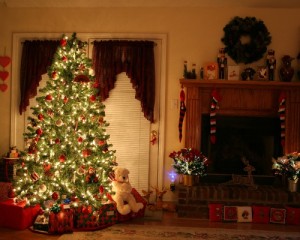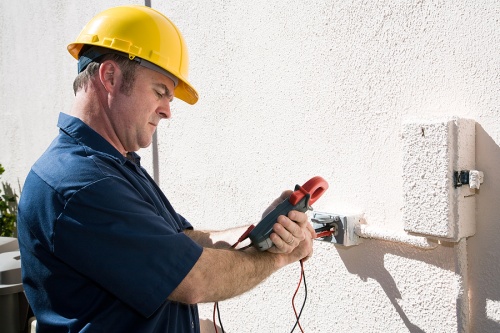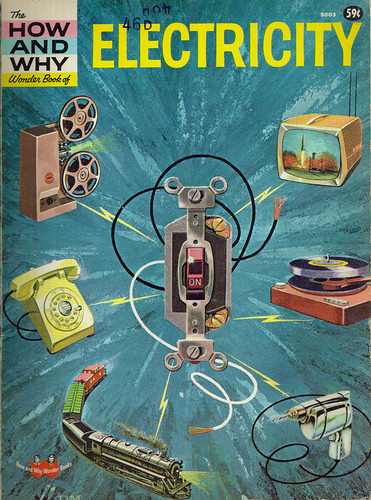The holiday season is upon us once again, this is a time when many people decorate their home for the holidays. Some families start decorating at Halloween and change their decorations for every holiday through New Year’s Eve. The key is to be safety conscious when decorating your home because no one wants the holidays to end in a disastrous accident.
 The following 10 holiday electrical safety tips will help you keep your family safe through the holiday season.
The following 10 holiday electrical safety tips will help you keep your family safe through the holiday season.
- Inspect Everything
Before using any holiday decoration, ensure that you inspect it closely. You will be looking for missing or broken bulbs, plugs, or sockets that are cracked or damaged, wires that are loose or bare, and any other type of damage. You will also want to inspect any extension cords that you use to connect holiday decorations. Remember, your holiday decorations have been in storage for the last year, holiday decorations can deteriorate or become damaged while they are in storage. - Do not Overload Electrical Outlets
One of the biggest and most dangerous mistakes that people make when decorating their homes for the holidays is to overload electrical outlets. Be sure not to overload your outlets, this is one of the number one causes of fires during the holidays. Ensure that you only plug one high wattage appliance into each outlet. It is also a good idea to use extension cords or power strips with circuit breakers installed as another level of safety. - Incandescent Lights
Incandescent lights are not commonly used for holiday decorations nowadays, but some people still love the look of the larger, brighter bulbs. If you use incandescent lights when decorating your home for the holidays do not connect more than 3 strings of these lights together. The reason for this is that incandescent bulbs require more wattage than modern LED lights, so when you connect more than 3 strings of incandescent lights in sequence you could blow a fuse or trip a breaker. This could lead to a fire. - The Christmas Tree
If you still have a live Christmas tree because of the look and smell do not let the tree dry out. Once a Christmas tree is cut, it can dry out quickly, water your tree every day to keep it as fresh as possible, and do not have it in the house for an extended period. Dried our Christmas trees are another of the top fire causing hazards in homes during the holiday season. - Candles
Most people love the look and scent of candles burning in their home during the holidays, but it is much safer to use battery-operated candles when possible. Unattended candles cause more than half of all holiday fires. If you must burn candles for your holiday celebrations, do so with caution. Never allow them to burn unattended and ensure that all candles are out when you go to bed. - Keep Clearance Around Heat Sources
If you are burning a fireplace, operating an electric or kerosene space heater, or using some other source of heat ensure that all combustible materials are at least 3 feet from the heat source. Combustibles include furniture, curtains, gifts with wrapping paper, the Christmas tree, and anything else that can catch fire easily and burn quickly. Again, many holiday fires are caused when combustible objects are left too close to a heat source. - Protect Cords from Damage
When you are installing your holiday decorations think about where the cords will be when you are done. Ensure electrical and extension cords are protected from being damaged. Make sure that they are not pinched by furniture, make sure that will not be hit by the vacuum, if used outdoors do not leave cords lying across driveways or walkways, and make sure all connections are watertight. Another thing to watch for is to make sure that closing doors or windows will not damage electrical cords, and keep them at least 3 feet from any heat sources. - Check all Decorations for Certification
Before you install your decorations look for a label that states the decoration has been inspected by an independent testing laboratory. Some of the most common labels you should be looking for are the UL tag for Underwriters Laboratories, the CSA tag that means the device was tested by the Canadian Standards Association, or the ETL tag which is from Intertek. If you cannot find any of these tags on the decorations you are using then do not use them. If the decorations are not tagged then they have not been inspected for safety and could be hazardous. - Stay in the Kitchen while Cooking
This safety rule applies all year around. When you are cooking holiday meals and snacks stay in the kitchen. Pans can boil over quickly, unattended cooking equipment can malfunction, and many other things can happen in a short amount of time leading to a fire. Make sure that someone is in the kitchen any time meals are being cooked, especially holiday meals which are normally bigger and require more equipment operating at the same time. - Bedtime
The last person that goes to bed at night should make sure that all decorations are turned off, unplugged, and extinguished. Unattended holiday decorations result in many home fires during the holiday season.
Bonus Safety Tip
The last tip is that if you have any questions or concerns about safely installing holiday decorations requiring electricity you should seek the advice of a local electrician like Conductive Electrical Contracting with a thorough knowledge of regulations set forth by the National Electric Safety board.






